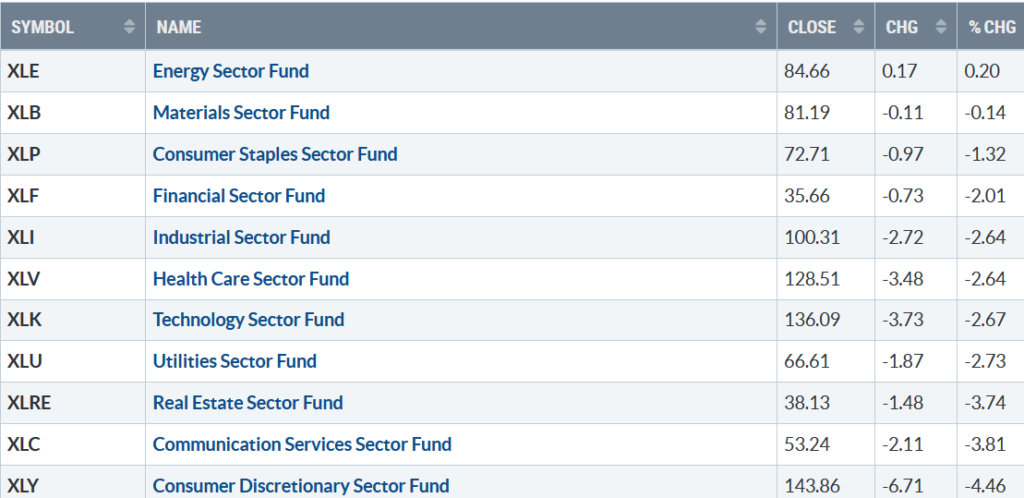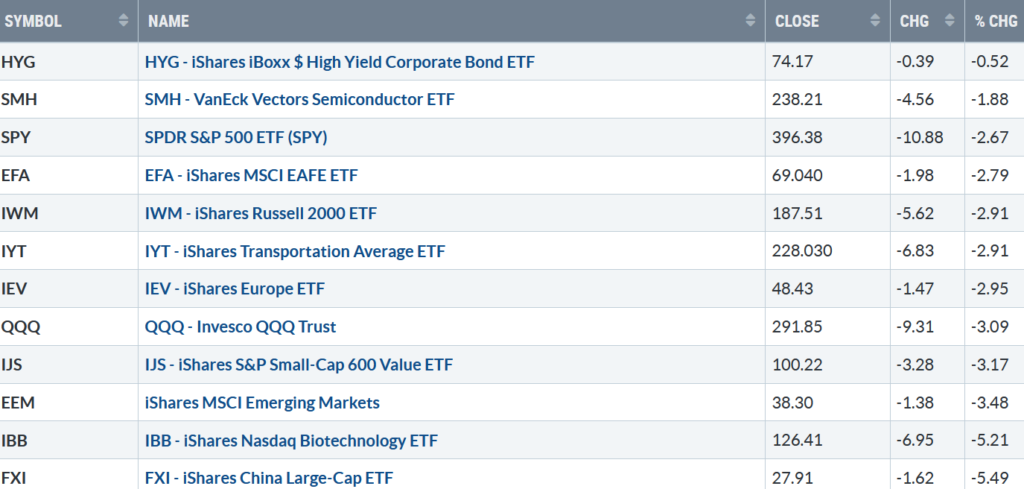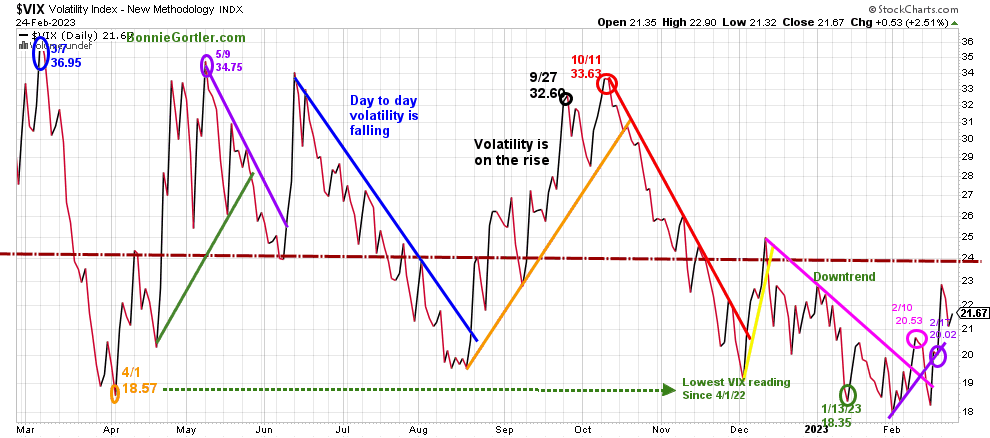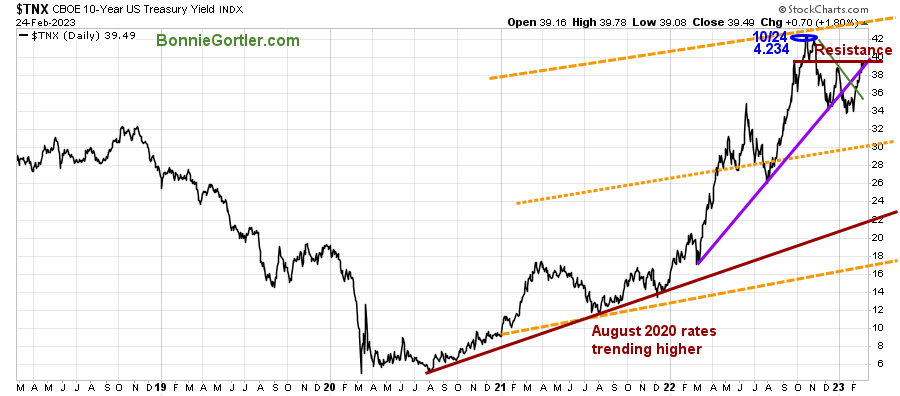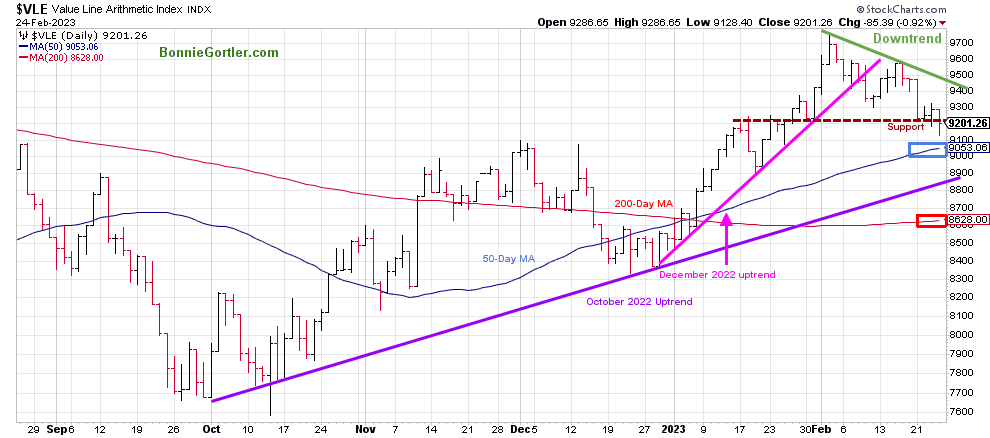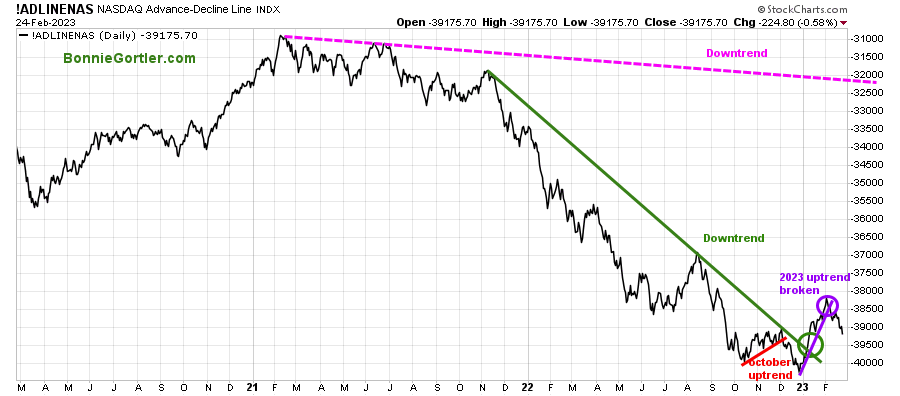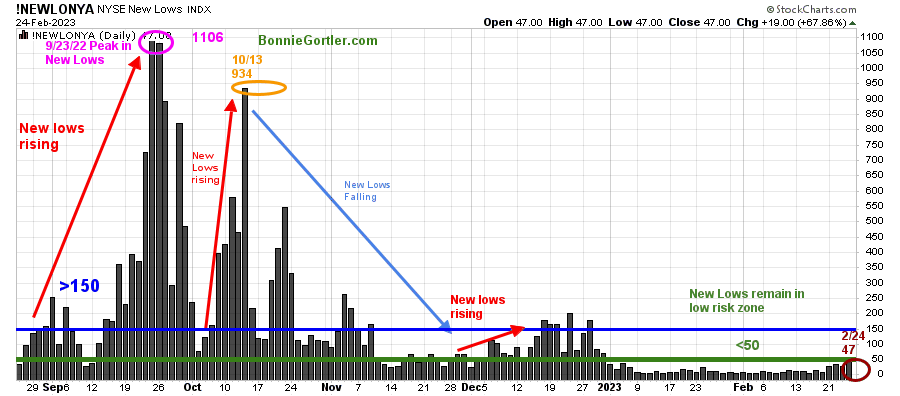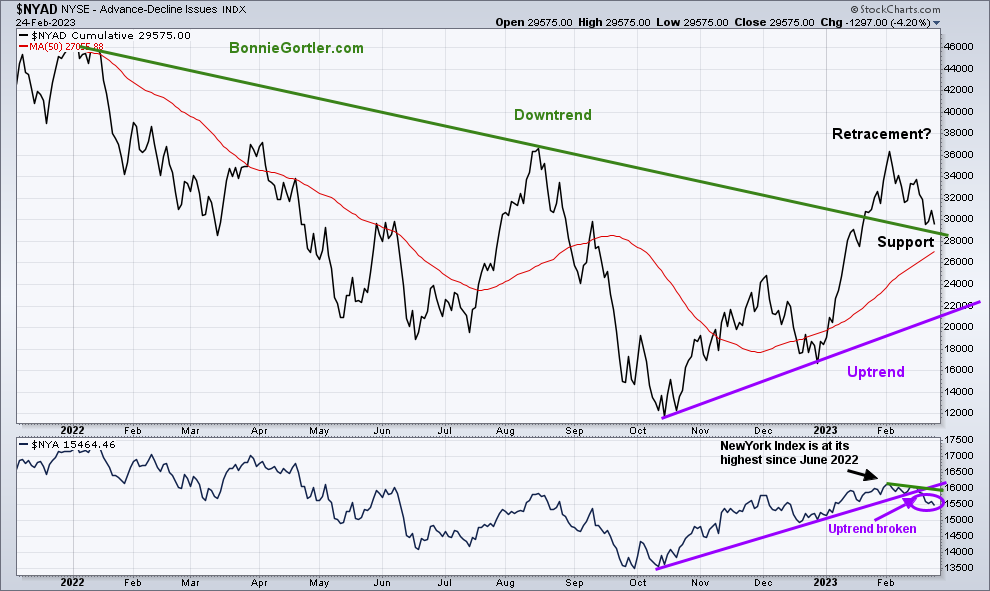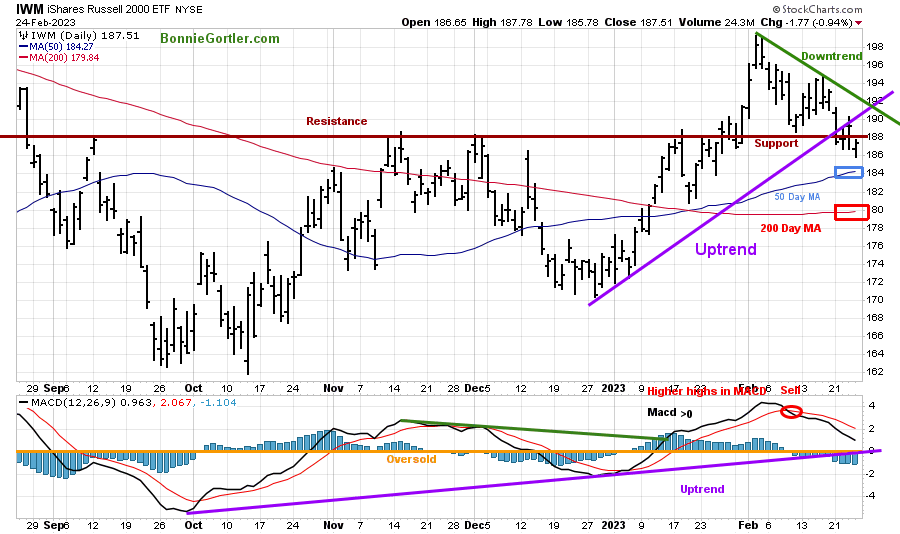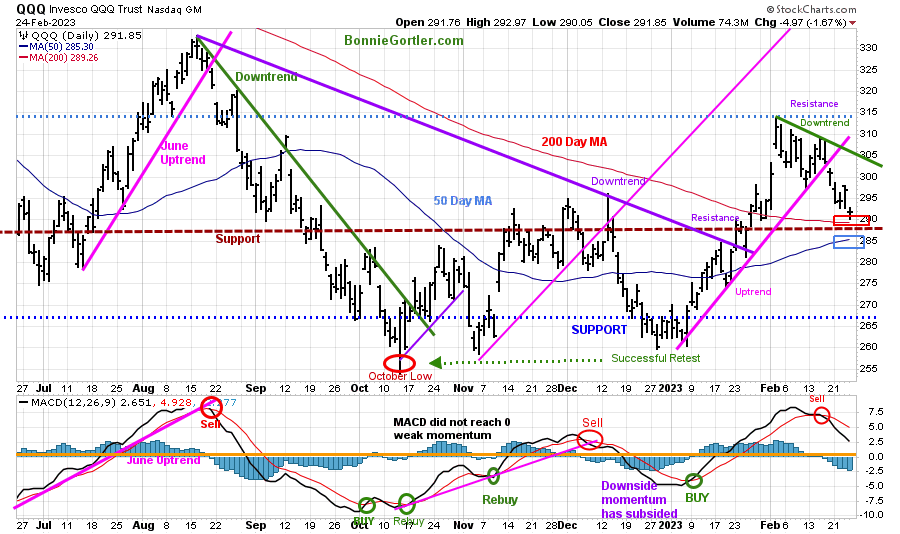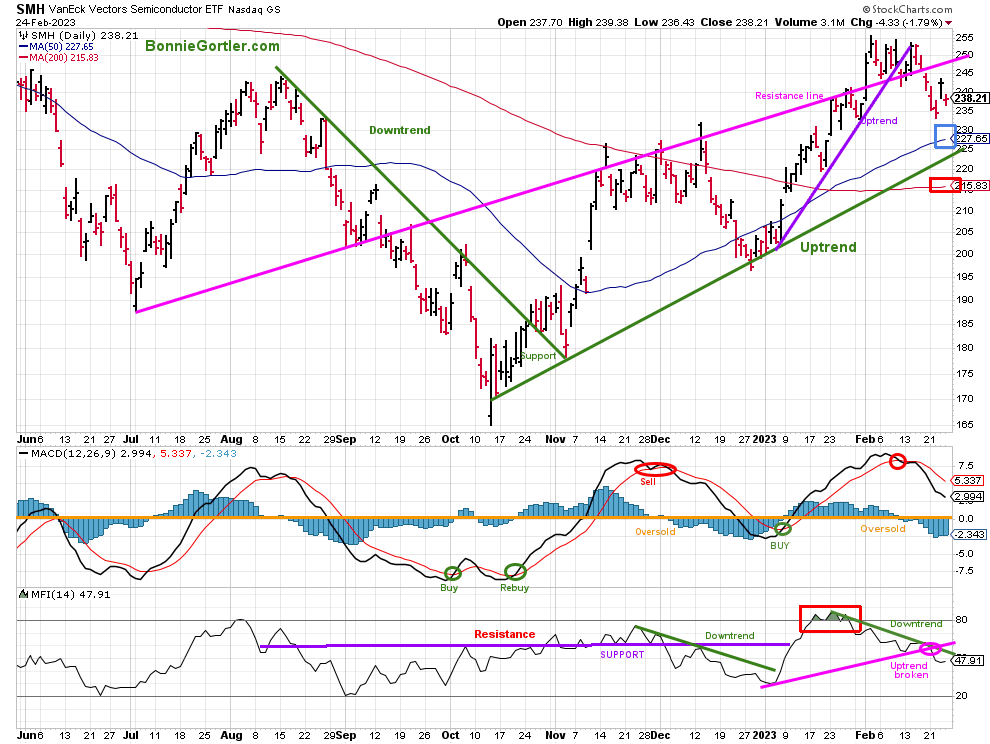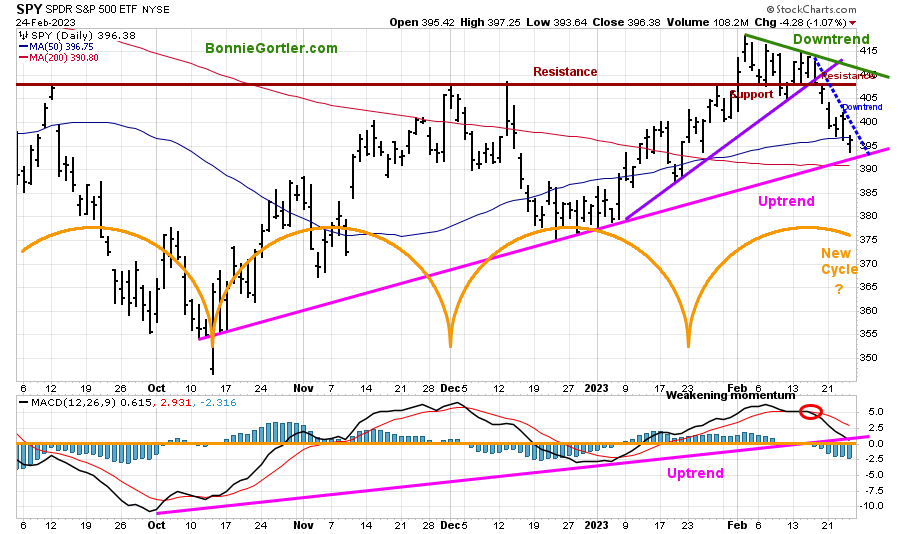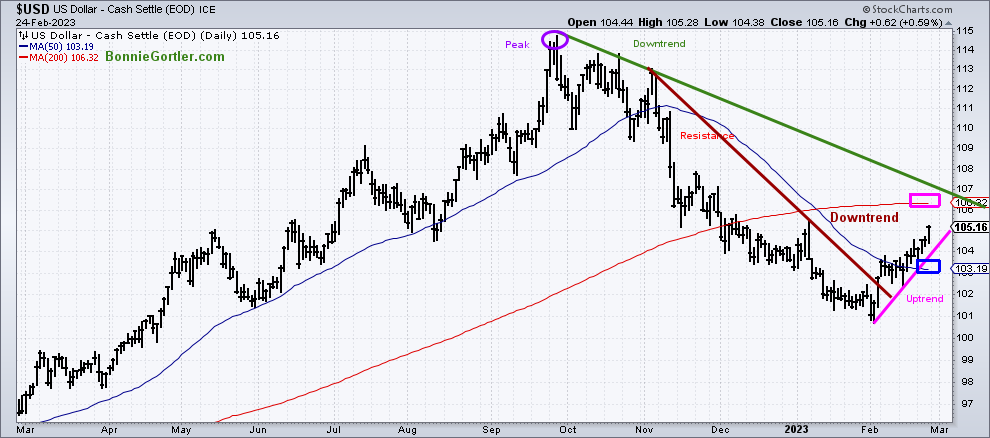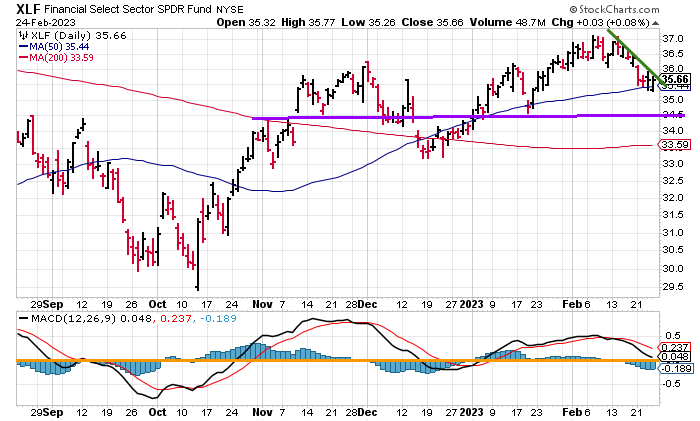Selling pressure accelerated last week, with ten of eleven S&P SPDR sectors negative. Energy (XLE) and Materials (XLB) were the leading sectors, and Communication Services (XLC) and Consumer Discretionary (XLY) were the weakest, with the SPDR S&P 500 ETF Trust (SPY) down -2.67%.
S&P SPDR Sector ETFs Performance Summary 2/17/23 – 2/24/23
Source: Stockcharts.com
Figure 2: Bonnie’s ETFs Watch List Performance 2/17/23 – 2/24/23
Source: Stockcharts.com
A broad decline with no sector to hide. Hi Yield Bonds continued their downward trend as risk was off, and International and U.S. markets fell, led by Emerging Markets and China. Small Cap Value and Growth, Transports, and Technology were down more than the S&P 500 (SPY), as investors shied away from high risk and were cautious.
Figure 3: CBOE Volatility Index VIX
Source: Stockcharts.com
The CBOE Volatility Index (VIX), a measure of fear, traded above 20.00 for most of 2022, with a high at 36.95 on 3/7 (blue circle) and a low on 4/1/22 at 18.57.
A new VIX low didn’t occur until 1/13/23 at 18.35 (green circle) after VIX quieted in early December 2022.
Last week, all the averages were lower, with VIX rising to 21.67 (purple circle) in volatile intraday trading, closing below its high of 22.87 on 2/21. If VIX continues higher and closes above 24.00, look for a more significant pullback. However, if VIX remains below 24.00 and moves lower, a short-term rally will likely begin soon, with the market oversold on a short-term basis.
Figure 4: UST 10YR Bond Yields Daily
Source: Stockcharts.com
The 10-Year U.S. Treasury yields continued to rise, closing at 3.949%, which helped spark selling by investors. Further, increased rates will likely add more selling pressure to equities. Support is 3.00%, and resistance is 4.20 and 4.40%.
The major averages for the week were all lower. The Dow was down -2.99% for its fourth consecutive week lower, now down for 2023. The S&P 500 was down -2.67 %, its worst week since last December, and the Nasdaq fell -3.33%. The Russell 2000 Index declined -2.87%, with no follow-through after being the strongest average the previous week.
Figure 5: Value Line Arithmetic Average
Source: Stockcharts.com
The Value Line Arithmetic Index ($VLE) (a mix of approximately 1700 stocks) fell sharply down -2.84% remaining in a downtrend and closing slightly below support at 9200. Key support lies at 9000, and resistance is at 9500.
Its positive VLE closed above the 50 and 200-Day Moving Average, a sign of underlying strength.
Weekly market breadth was negative on the New York Stock Exchange Index (NYSE) and for Nasdaq and deteriorating. The NYSE had 776 advances and 2469 declines, with 136 new highs and 78 new lows. There were 1303 advances and 3748 declines on the Nasdaq, with 191 new highs and 283 new lows.
There were more new lows than highs every day last week on the Nasdaq, which is negative and bears watching if this phenomenon continues.
Market breadth weakening
Figure 6: Nasdaq Advance Decline Line Daily
Source: Stockcharts.com
The Nasdaq daily advance-decline line is a technical indicator that plots the difference between the number of advancing and declining stocks daily.
In January, the October 2022 downtrend was broken (green line). In February 2023, the short-term uptrend gave way and is in the process of testing the low. Time will tell if the test will be successful.
A break above the February highs would be positive, implying a successful test of the low.
Watch the market breadth for successive days if there are more advances than declines this week or more declines than advances to give a clue for the short-term direction of the Nasdaq.
Figure 7: Daily New York Stock Exchange (NYSE) New Lows
Source: Stockcharts.com
Watching New Lows on the New York Stock Exchange is a simple technical tool that helps awareness of the immediate trend’s direction.
New lows warned of a potential sharp pullback, high volatility, and “panic selling” for most of 2022, closing above 150. The peak reading was 9/23/22 when New Lows made a new high of 11/06 (pink circle).
New Lows rose last week, up from 10 on 2/17, closing at 47 on 2/24 (brown circle), no longer in the lowest risk zone below 25, but remaining below 50 where the market is positive (Low Risk and prices tend to rise).
On the other hand, a rise above 150 and an expansion of New Lows would be a warning of more weakness forthcoming.
Learn more about the significance of New Lows in my book, Journey to Wealth, published on Amazon. If you would like a preview, get a free chapter here.
Figure 8: Daily New York Stock Exchange (NYSE) Cumulative Advance-Decline Line (Top) and NYSE (Bottom)
Source: Stockcharts.com
The above chart is the cumulative Advance-Decline Line (AD Line) of the NYSE, a breadth indicator based on the number of advancing stocks minus the number of declining stocks.
The 2022 downtrend that was broken (green line top chart) remains positive, with the AD-Line making a higher high, confirming the February NYSE’s high. The AD-Line has retraced to where it broke out from and is the support that bears watching.
The AD line and NYSE turned down last week, with the October uptrend for the AD line intact (purple line top chart), but the NYSE broke below its uptrend.
Continued weakness in the AD-Line (top chart) would warn of potentially lower prices in the short term. On the other hand, a turn-up in the AD-Line and the New York Index breaking the downtrend (green line lower chart) would be bullish.
Learn more about charting in my free Masterclass, Charting Strategies to Cut Risk and Trade with the Trend. Sign up here.
Figure 9: Daily iShares Russell 2000 (IWM) Price (Top) and 12-26-9 MACD Bottom)
Source: Stockcharts.com
The top chart is the daily iShares Russell 2000 Index ETF (IWM), the benchmark for small-cap stocks, with a 50-Day Moving Average (MA) (blue line) and 200-Day Moving Average (MA) (red line) that traders watch and use to define trends.
IWM reversed lower last week, closing at 187.51, down -2.91%, weaker than the S&P 500 but remained above its 200-Day MA (red rectangle) and 50-Day MA (blue rectangle).
MACD remains on a sell, above 0 (orange line), but remains in an uptrend for 2023 after making a higher high, a sign of underlying strength.
Support is at 184.00 and 180.00. Resistance is at 188.00,192.00, 195.00, and 199.00.
With the daily IWM December 2022 uptrend in effect, confirmed by a higher high in MACD, and the intermediate trend favorable (chart not shown), despite the sell, the odds favor IWM challenging the February highs from earlier this month after the latest decline has run its course.
Learn about coaching with Bonnie. Ask questions. Discover more about the coaching processes in this 15-minute call by emailing me at Bonnie@BonnieGortler.com. I would love to schedule a call and connect with you.
Figure 10: Daily Invesco QQQ Trust (QQQ) Price (Top) and 12-26-9 MACD (Bottom)
Source: Stockcharts.com
The chart shows the daily Invesco QQQ, an exchange-traded fund based on the Nasdaq 100 Index. QQQ made a low in October 2022 (red circle), followed by a successful retest of the low in early January 2023, then broke the downtrend (purple line) and hit a new six-month high in February.
QQQ broke the 2023 uptrend (pink line) the previous week but reversed lower -3.09% last week, closing at 291.85. but remains above the 50-Day Moving Average and the 200-Day Moving Average (red rectangle).
The old resistance area (brown dotted line) is acting as support at 287.00. Resistance is at 300.00, 305.00, 310.00, and 314.00.
The bottom chart is MACD (12, 26, 9) on a sell and falling. With the strength of the rise in QQQ in 2023, MACD at the highest reading since August, and the intermediate trend favorable (chart not shown), the odds favor the first sell to be premature and higher prices to follow.
On Friday, it was a positive sign that QQQ closed near the top of its range and above both 50 and 200 Day Moving Averages, and the weekly chart remained in an uptrend since October.
Only time will tell if the rally will resume.
Figure 11: Daily Van Eck Vectors Semiconductor (SMH) Top, 12-26-9 MACD (Middle) and Money Flow (Bottom)
Source: Stockcharts.com
The top part of the chart shows the Van Eck Vectors Semiconductor (SMH) concentrated, mainly in US-based Mega-Cap Semiconductors companies. SMH is a lead indicator for the market when investors are willing to take on increased risk and the opposite when the market is falling.
Semiconductors (SMH) is holding up better than many industry groups, falling -1.88% last week, closing at 238.21, a leading sector, in 2023. SMH broke its steep 2023 uptrend (purple line) but remains in the longer-term uptrend since October (green line) and above both its 50 and 200-Day Moving averages (blue and red rectangle).
SMH support remains at 235.00, 226.00, 220.00, and 215.00. Resistance is at 245.00, 250.00, and 255.00.
MACD (middle chart) remains on a sell, showing weakening momentum after its gains working off its overbought readings and getting closer to below 0, oversold where a new buy can occur.
Money Flow (bottom chart) peaked (red rectangle) and turned down from an overbought level, and is trending down no longer in its 2023 uptrend. Time will tell if Money Flow will be strong enough to break the downtrend and begin a second leg higher, adding to its 2023 gains. It’s favorable the intermediate uptrend in SMH remains intact. Watch if SMH shows leadership or is weak next week for a clue of the market direction.
Figure 12: The S&P 500 Index (SPY) Daily (Top) and 12-26-9 MACD (Bottom)
Source: Stockcharts.com
The S&P 500 (SPY) made a six-month high in early February and turned down.
SPY was under selling pressure closing at 396.38, down -2.67% for the week after breaking the uptrend (purple line) and support (brown line) and falling slightly below the 50-Day Moving Average (blue rectangle) but off its worst level on Friday. Its positive SPY remains above 200-Day Moving Average (red rectangle), and the uptrend from October 2022 remains intact.
MACD (lower chart) is on a sell, showing weakening momentum threatening to break the uptrend from October. An immediate turn-up would be favorable. However, continued weakness in momentum would be a sign the decline has further downside toward the January lows.
Support is 390.00 and 380.00, while resistance is 400.00, 404.00, 408.00, and 415.00.
A close above 404.00 would imply a possible short-term cycle bottom occurred on Friday, and above 415.00 would break the February downtrend (green line) and likely trip buy stops fueling the next leg up.
Figure 13: U.S. Dollar Daily
Source: Stockcharts.com
The U.S. dollar (USD) peaked in September 2022 and trended lower into early 2023, making a low in February.
USD closed up +1.33% for the week, its highest level since January 2023, closing near its high of the day and week at 105.16. USD remains above the November daily downtrend (brown line) but below the September 2022 downtrend (green line). The downside objective of 98.80 (lower pink dotted line) was negated last week after closing above 104.00, now a key support area.
If the dollar continues to rise, look for more selling pressure in international and U.S. markets. But, on the other hand, if the dollar weakens, international and U.S. equities are likely to firm and work their way higher.
Keep an eye on Financials which closed up on Friday.
Figure 14: The Financial Select Sector SPDR (XLF) Daily (Top) and 12-26-9 MACD (Bottom)
Source: Stockcharts.com
Financials (XLF) fell early in the week but closed near their highs on Friday, above their 50 Day Moving Average and close to breaking their February downtrend. Continued strength would support U.S. Equities and potentially be a leading sector over the next several weeks to months.
Summing Up:
Investors were cautious last week as inflation reports were hotter than expected. Bond yields rose, the dollar moved higher, and global markets and the major averages sold off sharply. The market breadth and short-term momentum indicators weakened but are no longer extended and now hovering near key support levels. With the intermediate trend favorable, a potential short-term cycle bottom due in the S&P 500, if the broad market and yields stabilize, breaking the short-term downtrend, a test of the February highs is likely.
Remember to manage your risk, and your wealth will grow.
Let’s talk investing. You are invited to set up your Free 30-minute Wealth and Well-Being Strategy session by clicking here or emailing me at Bonnie@BonnieGortler.com. I would love to schedule a call and connect with you.
Disclaimer: Although the information is made with a sincere effort for accuracy, it is not guaranteed that the information provided is a statement of fact. Nor can we guarantee the results of following any of the recommendations made herein. Readers are encouraged to meet with their own advisors to consider the suitability of investments for their own particular situations and for determination of their own risk levels. Past performance does not guarantee any future results.


